*This post may contain affiliate links. Read more »
Picture this: tender Chinese eggplant, or tofu grilled to perfection, and bathed in a luscious, finger-licking sauce that's got a kick and depth like no other. There is a reason this Korean BBQ Sauce Recipe is a staple in my home, and we use it on everything from crispy fried seitan, to gloriously char-grilled bok choy.
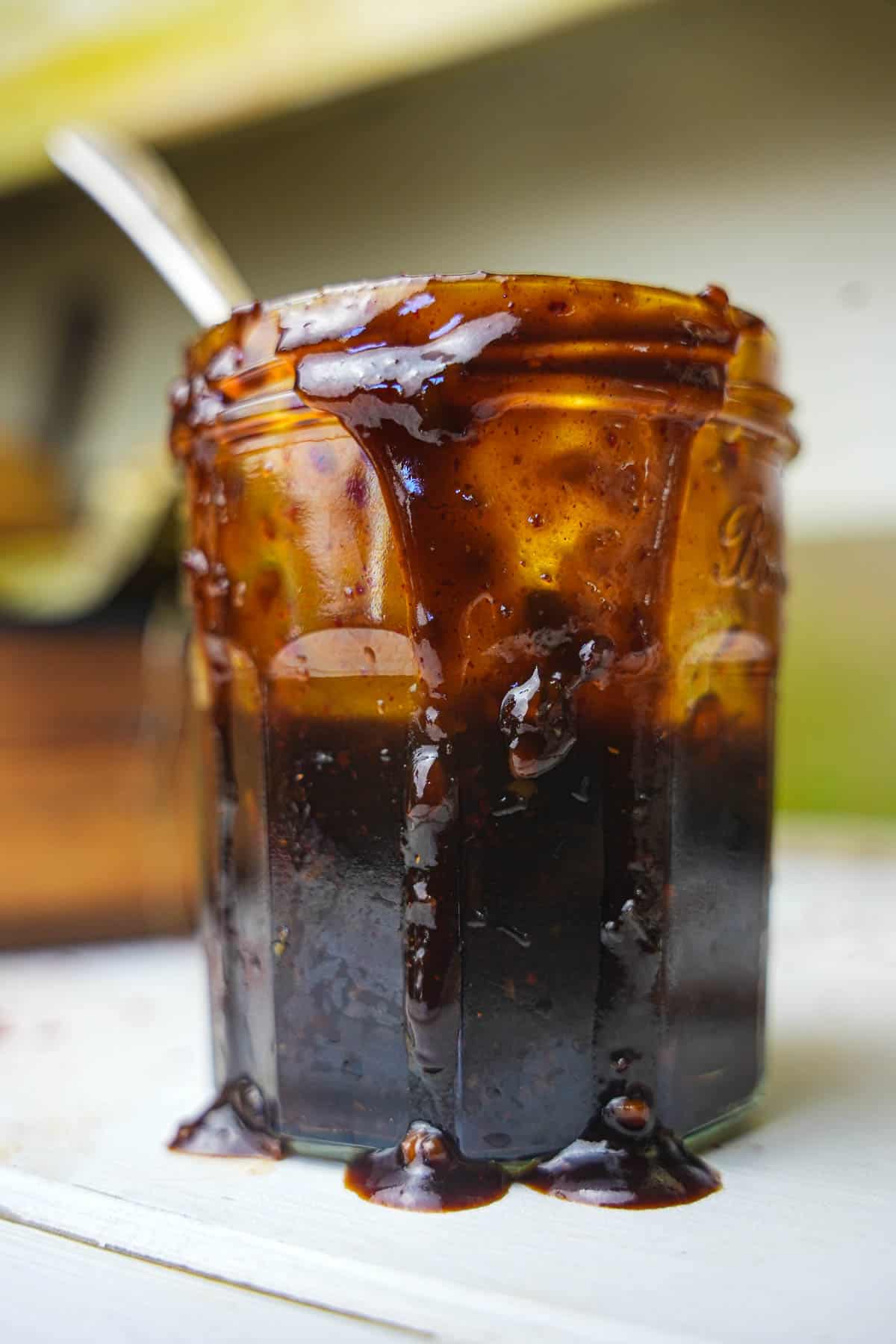

Enter your email & I'll send it to your inbox. Plus, get great new recipes from me every week!
By submitting this form, you consent to receive emails from Cinnamon Snail.
Everything about this sauce is perfectly balanced and ideal for your favorite grilled, smoked, or roasted recipes. I love adding some dabs of it to my seitan bulgogi, or drizzling some on top of my kimchi fried rice. It’s even the bomb on noodle dishes like pad woon sen, bami goreng, or mie goreng.
A scallion, minced into tiny green confetti, fresh garlic, and ginger enlivened with hot sesame oil kick the flavor party off. Tamari, gochujang paste, and brown sugar form the dark and rich foundation of this sauce. This umami powerhouse is about to bring the magic, infusing this sauce with a depth that'll have you grabbing your grill brush to go mayyyyybe a little overboard.
Grab your grill brush, let’s whip this Korean marinade recipe up, and get to slathering!
Jump to:
- 🥰Why you'll love this Korean bbq sauce recipe
- 🌶️ Korean bbq sauce Ingredients
- 🤯Different Korean BBQ Sauce Recipes based on this one
- 📖How to make this Korean BBQ Sauce recipe
- 💡Serving Ideas
- ⭐️ Essential tips to NAIL this Korean BBQ sauce recipe:
- 🤷♀️FAQ
- 🤷 What should you put Korean barbecue sauce on?
- Korean BBQ Sauce Recipe (Gochujang Barbecue Marinade)
🥰Why you'll love this Korean bbq sauce recipe
🕰️Time Is on Your Side: Imagine this - a flavor-packed, homemade BBQ sauce that takes less than 10 minutes to whip up. No lengthy preparations, no blender or expensive gear are needed. Just pure deliciousness in record time.
🌿Vegan AF and GF: You can love this sauce even if you aren’t a level 10 vegan who doesn’t eat anything that has a shadow. But if you are into that, like all of my vegan sauce recipes, this Korean barbecue sauce has got your back. It also happens to be one of my completely gluten-free vegan recipes too, providing that you use tamari in it and use a wheat free gochujang in the recipe.
✅Tested and Approved Worldwide: Like all the vegan recipes on my blog, this gochujang bbq sauce has been meticulously fine-tuned not only by me but by a team of dedicated recipe testers around the world, including in Korea where the dish is from. No matter where you are on the planet, rest assured it's been tested to work everywhere!


🥰 Upgrade your Vegan Gluten-Free cooking chops!
Hate gluten with all of your heart? This 5-day program is 100% FREE. Let's get you mastering plant-based cooking!
🌶️ Korean bbq sauce Ingredients
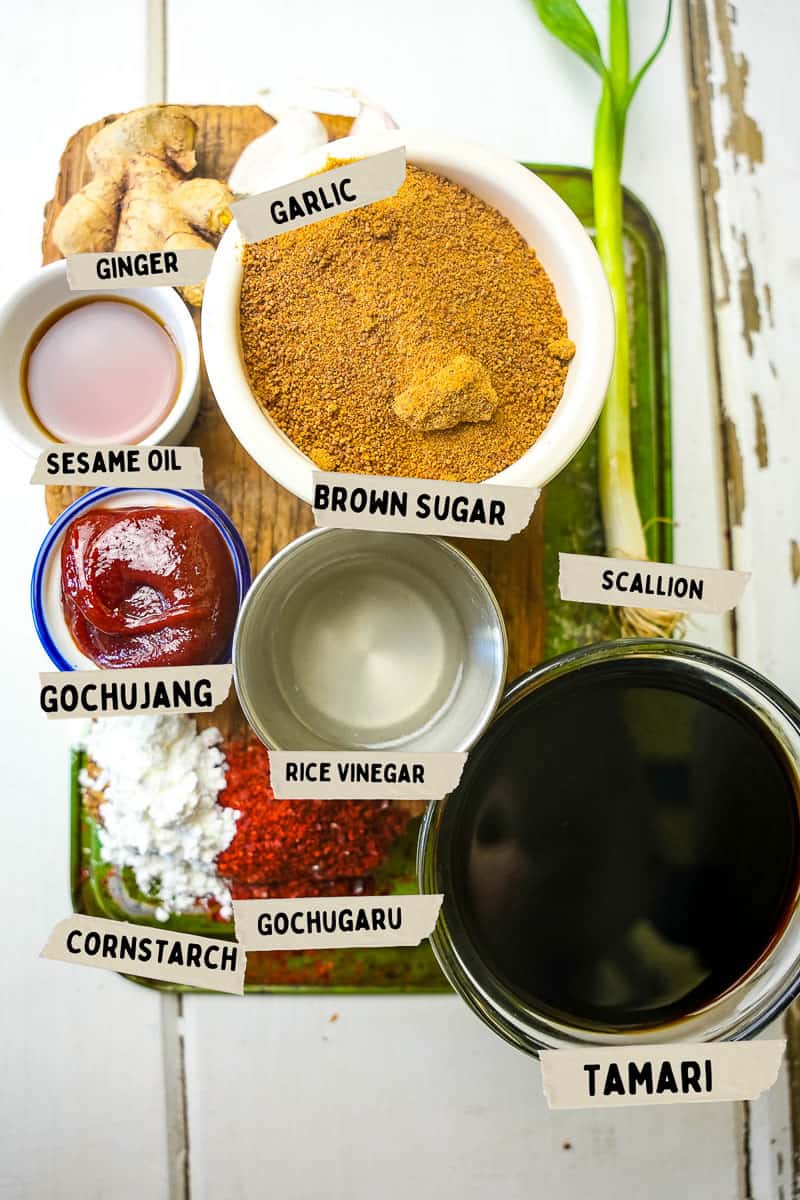
Gochujang
Gochujang, a staple in Korean cuisine, is a fermented chili paste that brings a unique depth of flavor to any dish it graces. Its robust and slightly sweet profile, with a hint of umami, adds a captivating kick to the Korean BBQ sauce. Any good Korean grocery store will sell many varieties and brands. However, if you don't have gochujang on hand, don’t dismay! Homemade nam prik pao, or Sriracha, the iconic chili garlic sauce is a bit thinner but can step in as a worthy substitute.
Sugar
Brown sugar, with its caramel-like richness and molasses undertones, adds a delightful touch of sweetness to this Korean BBQ sauce. But for those seeking an alternative to cane sugar, coconut sugar steps in as a fantastic substitute. Derived from coconut palm trees, it offers a natural and earthy sweetness that harmonizes beautifully with the sauce's flavors. Coconut sugar not only brings its unique character to the mix but also contains trace minerals like iron, zinc, and potassium. It's a wholesome choice that caters to different taste preferences and dietary needs, elevating the sauce to new levels of flavor.
Tamari
Tamari, a key ingredient in this recipe, is a type of soy sauce that originates from Japan. It is known for its rich, savory flavor and is typically made with little to no wheat, making it a suitable option for those following a gluten-free diet. Its deep umami notes enhance the overall taste profile of the Korean BBQ sauce.
In place of tamari, you can use Korean Soy Sauce, Dark Soy Sauce, Low Sodium Soy Sauce, or Nama Shoyu which is a raw fermented soy sauce. These substitutes for tamari typically contain wheat and are not gluten-free.
Gochugaru
Gochugaru, Korean chili flakes are a crucial ingredient in Korean cuisine, lending its vibrant heat and slightly smoky flavor to this recipe. I use unsalted coarse-grade gochugaru, which has the most pronounced and freshest flavor without pushing the recipe to become too salty. I also use it in making kimchi, and it has become one of my favorite chili pepper flakes to use in a variety of non-Korean recipes.
If gochugaru is unavailable, you can consider substitutes such as crushed red pepper flakes, although they tend to be a bit hotter, and they also typically have seeds. Smoked paprika can also be used, offering a milder, sweeter flavor.
Rice vinegar
Rice vinegar, a staple in Asian cuisine, is crucial for balancing the sweetness and adding important acidity that allows this Korean BBQ sauce to be absorbed by the food you put it on. If you don't have rice vinegar, you can easily substitute it with rice wine vinegar, which shares a similar flavor profile. Alternatively, apple cider vinegar can be used as a replacement, offering a hint of fruity acidity to the sauce.
*See the recipe card at the bottom of the page for exact quantities, nutritional info, and detailed cooking directions.
🤯Different Korean BBQ Sauce Recipes based on this one
👉 Bulgogi sauce
Bulgogi sauce is a bit fruitier tasting than regular Korean BBQ Sauce. Generally, bulgogi sauce has grated fresh nashi pear added to it, although some recipes achieve a similar flavor by using apple sauce instead.
👉 Hoisin-Ginger Korean BBQ Sauce
Add two tablespoons of hoisin sauce to the base recipe for a rich and slightly sweet flavor. Step up the flavor with some roasted sesame seeds and a teaspoon of freshly grated ginger. Since the ginger that's already in this sauce is cooked, this adds an intense dimension of raw ginger flavor.
👉 Smoked chili Korean bbq sauce recipe
Add a generous spoonful of minced chipotle peppers in adobo sauce to this marinade and get ready for a smoky and robust flavor that lights grilled flavors ablaze! I used this variation ALL THE TIME on my food truck, the Cinnamon Snail, where I also added a big splash of good quality Asian sesame oil to help the smoked chili flavor really penetrate the food.
📖How to make this Korean BBQ Sauce recipe
This upgrade to your homemade Korean food is crazy-easy to make, and I am going to show you how it should look each step of the way. Or you can follow along with the easy-to-print recipe card towards the bottom of this page.

Step 1
Mince the garlic and ginger. I like to use a microplane to get the ginger extra-tiny, but you can also just mince it by hand or with a grater.

Step 2
Grab a saucepan and heat the toasted sesame seed oil over medium heat. Add freshly grated ginger, minced garlic, and chopped green onions. Sauté these aromatic ingredients for two minutes, making sure to keep an eye on the garlic. We don't want any burnt flavors here.
If you want to, you can add few tablespoons of shredded Korean pear at this stage.

Step 3
Add in the tamari, a little sugar (brown suga, rice vinegar, gochujang (or sriracha), and gochugaru (or crushed red pepper flakes). Feel free to adjust the amount of gochujang or sriracha to your personal heat preference. Let your taste buds guide you.
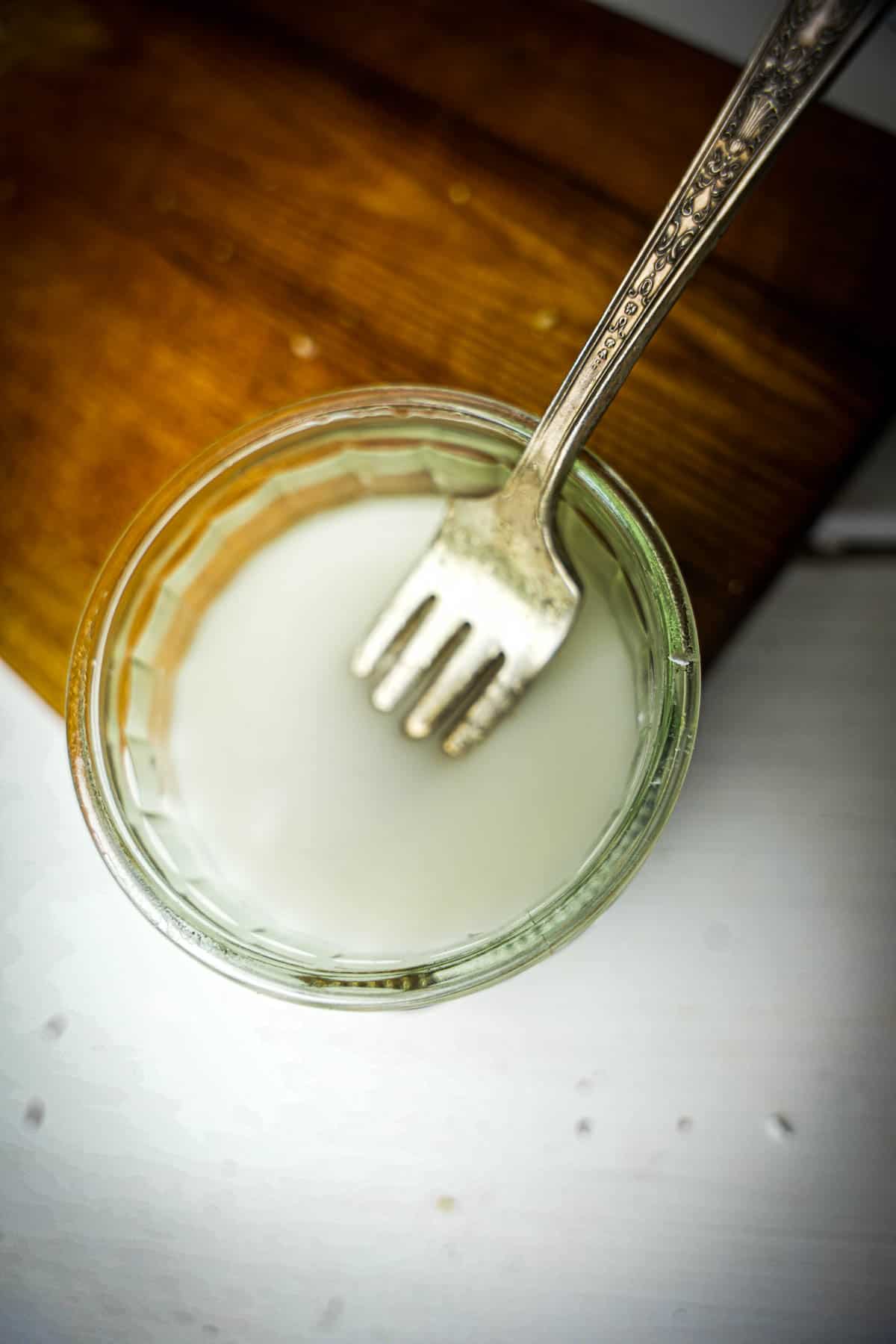
Step 4
In a small bowl, whisk together the water and cornstarch until you achieve a smooth, thin slurry.

Step 5
Once the sauce on the stove reaches a good boil, pour in that water-cornstarch mixture, and whisk to combine. The sauce will thicken for a couple of minutes as it cooks to your desired consistency.
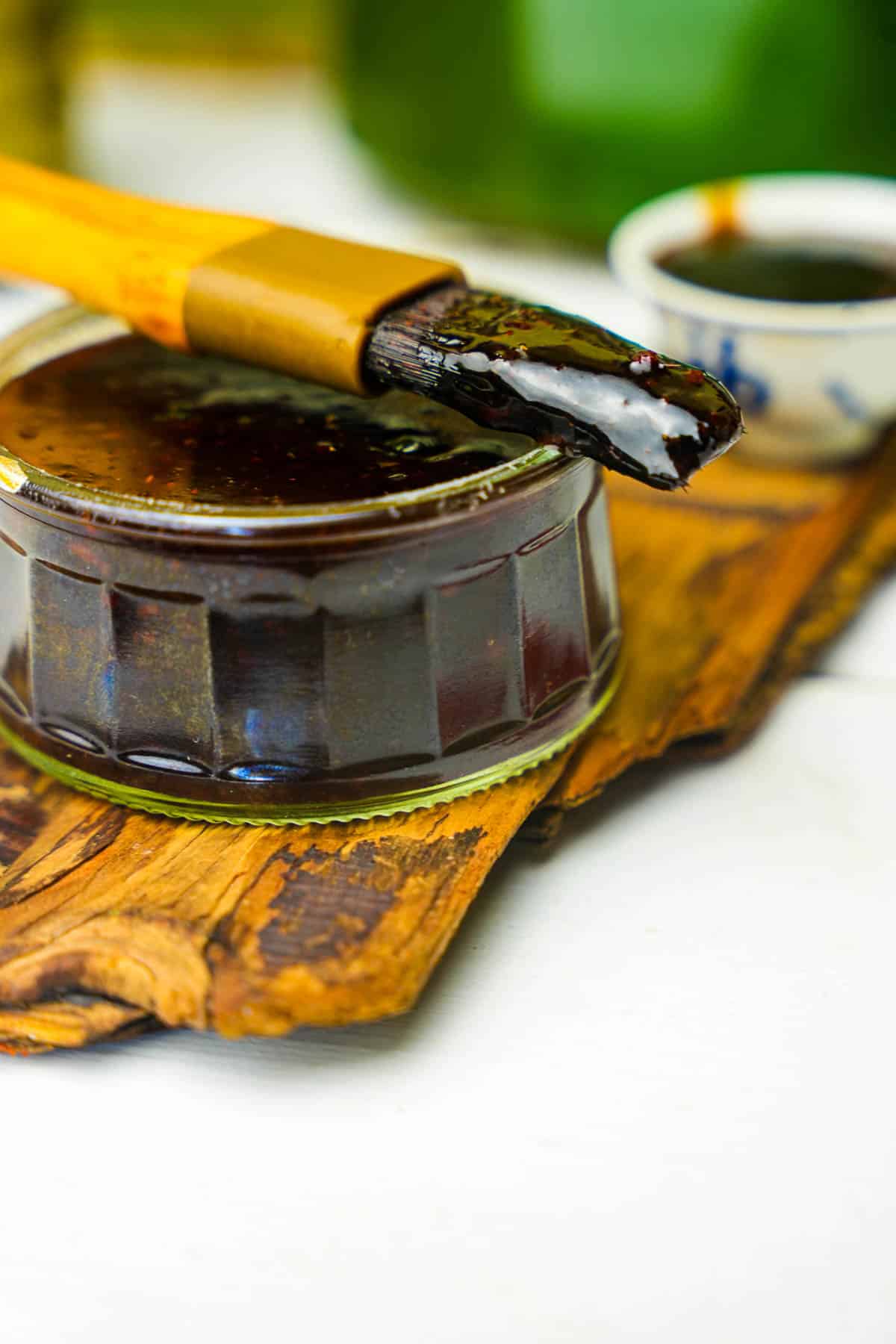
Step 6
Remove the sauce from the heat and let it cool down a bit. We want those flavors to mingle and harmonize as it cools.
💡Serving Ideas
You now have in your arsenal the best korean bbq marinade to turn your meals up to the next level with! Brush it on fresh vegetables (in place of typical non-veg items like pork belly or rib eye) and then cooking them over an open flame, on a charcoal grill, or on a gas grill. I highly recommend serving those gorgeously caramelized, and lightly charred veggies over my kimchi fried rice, tom yum fried rice, or khao pad.
It’s a delicious marinade sauce to drizzle onto my seitan bulgogi recipe (think of it as vegan Korean bbq beef), or even to pour onto tofu katsu. I am also a huge fan of making vegan fried chicken wings, and having this sauce all over it, dripping off in sticky, deep tasting drops. You can use this recipe as a general stir-fry sauce for making noodles (such as bihun goreng) or even just perking up some plain ol' white rice.
To brighten up the flavors of a meal, I love serving dishes made with this sauce with side dishes of fried tofu, banana leaf steamed rice cakes, or yamagobo (pickled burdock root).

⭐️ Essential tips to NAIL this Korean BBQ sauce recipe:
- Watch the Garlic Closely: When sautéing the garlic and ginger in sesame oil, make sure it doesn't burn. Burnt garlic will add a bitter flavor to the sauce, so keep the heat at medium, use a thick bottomed saucepan, and stir constantly.
- Adjust the Heat to Your Preference: The amount of gochujang or sriracha can be tweaked based on your desired spice level. Start with less if you're unsure, and add more gradually until it suits your taste.
- Mix Cornstarch Slurry Thoroughly: Before adding the cornstarch mixture to the sauce, ensure it's fully dissolved in water to avoid any lumps.
- Let the Sauce Simmer: After adding the cornstarch mixture, allow the sauce to simmer for a few minutes until it thickens to your preferred consistency. Stir frequently to avoid sticking or uneven thickening.
🤷♀️FAQ
The origins of Korean BBQ, known as "Gogi-gui" in Korean, can be traced back centuries ago when open-fire grilling methods were commonly used in Korean cuisine.
In ancient times, Koreans utilized various grilling techniques to cook meats, often using small, portable grills or open pits. These methods allowed them to enjoy the flavors and textures of grilled meats such as Korean short ribs, flank steak, pork chop, or formed ground meat in social gatherings and celebrations.
However, it wasn't until the 20th century, during the post-Korean War period, that Korean BBQ as we know it today gained popularity. As South Korea experienced an economic boom and urbanization, people sought out more dining-out experiences. This led to the rise of specialized restaurants dedicated to Korean BBQ.
The introduction of tabletop grills, where diners could cook their own meat right at the table, revolutionized the Korean BBQ experience. This interactive dining style allowed for a lively communal atmosphere, where friends, family, and colleagues could gather and enjoy the process of grilling bulgogi meat together.
Traditionally, Korean Barbecue primarily focused on beef, with cuts like bulgogi (marinated thinly sliced beef) and galbi (marinated beef short ribs) being the star attractions. Over time, pork, chicken, and plant-based proteins also found their way onto Korean BBQ menus, offering a wider variety of options for diners to savor.
Korean BBQ is known for its emphasis on marinades and sauces that enhance the flavors of the grilled meats. Each region and restaurant may have its own unique marinade recipes, often featuring a combination of soy sauce, garlic, ginger, sesame oil, and other aromatic ingredients.
Today, Korean BBQ has gained international popularity, with Korean BBQ restaurants found around the world. It has become a beloved culinary experience, showcasing the art of grilling meats and the communal enjoyment of shared meals. Korean BBQ continues to evolve and adapt, incorporating new flavors and techniques while honoring its historical roots.
Korean BBQ sauce can be gluten-free depending on the ingredients used. Traditional Korean BBQ sauce typically contains soy sauce, which is commonly made from fermented soybeans and wheat. Many Korean BBQ Sauce recipes also contain gochujang which is sometimes thickened with wheat flour or wheat starch.
There are gluten-free gochujangs and soy sauce options available, such as tamari or specifically labeled gluten-free soy sauce, that can be used to make a gluten-free version of the sauce.
This recipe if followed using tamari and gluten-free gochujang is safe for anyone with a gluten sensitivity.
Once prepared, transfer the sauce to an airtight container and refrigerate. The sauce can be stored in the refrigerator for up to two weeks, allowing you to enjoy its flavors with many meals. However, please note that freezing is not recommended, as it can negatively impact the texture and consistency of the sauce.
In terms of flavor and use, Korean BBQ sauces are worlds apart from American-style BBQ sauces. While American BBQ sauces tend to be tangy, sweet, often tomato-based, and smoky, Korean BBQ sauces have a complex flavor profile with elements of umami, sweetness, and spiciness.
🤷 What should you put Korean barbecue sauce on?
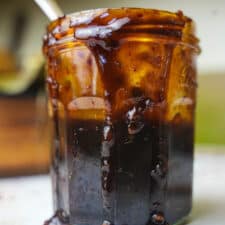
Korean BBQ Sauce Recipe (Gochujang Barbecue Marinade)
Ingredients
- 1 tablespoon toasted sesame oil
- 2 teaspoons grated fresh ginger
- 3 cloves garlic minced
- 1 scallion minced
- ⅔ cup tamari or other soy sauce of your preference
- ½ cup light brown sugar or coconut sugar
- 2 tablespoons rice vinegar
- 2 tablespoons gochujang or sriracha
- 2 teaspoons gochugaru Korean chili flakes, or crushed red pepper flakes
- ¼ cup water
- 2 teaspoons cornstarch
Instructions
- In a saucepan over medium heat, warm the toasted sesame oil. Add the freshly grated ginger, minced garlic, and minced scallion. Sauté for two minutes until fragrant, being careful not to burn the garlic.
- Add the in the tamari, sugar, rice vinegar, gochujang (or sriracha), and gochugaru (or crushed red pepper flakes). These ingredients contribute to the sauce's distinctive Korean BBQ flavor. Adjust the quantity of gochujang or sriracha according to your desired level of spiciness.
- In a small bowl, whisk together the water and cornstarch until smooth. This mixture will act as a thickening agent for the sauce.
- Once the sauce on the stove has come to a boil, pour the water-cornstarch mixture into the saucepan and stir well with a whisk. Continue cooking over medium heat until the sauce thickens to your desired consistency, usually a few minutes.
- Once the sauce has thickened, remove it from the heat and let it cool slightly. The flavors will continue to develop as the sauce cools.
Notes
Cooking Tips:
- To intensify the flavors, you can marinate your choice of protein or vegetables in a portion of the sauce for a few hours or overnight before grilling or cooking. If you intend to use this sauce as a marinade only, leave the cornstarch out. The thinner consistency allows the marinade to be more easily absorbed by vegetables or proteins.
- If you prefer a smoother sauce, you can strain it through a fine-mesh sieve to remove any ginger or garlic bits.
- Feel free to adjust the sweetness or spiciness of the sauce to your taste by adding more or less brown sugar or gochujang/sriracha.
- Store the sauce in an airtight container in the refrigerator for up to a week. Before using, give it a good stir as some separation may occur. Avoid freezing the sauce, as the texture and consistency may be affected.

Enter your email & I'll send it to your inbox. Plus, get great new recipes from me every week!
By submitting this form, you consent to receive emails from Cinnamon Snail.


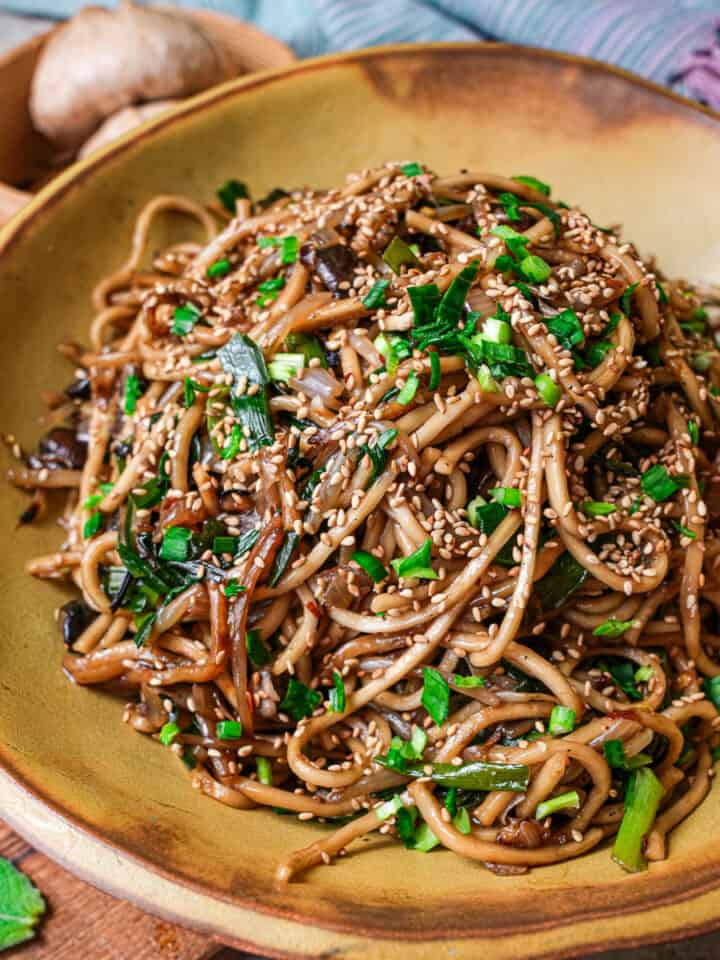
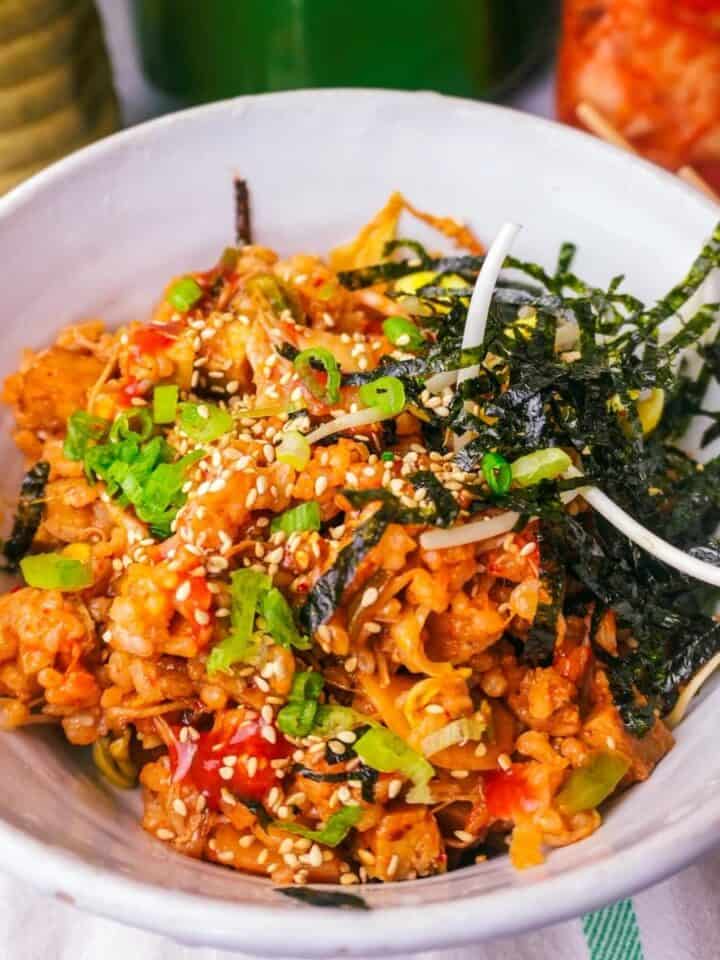







Nick Harris says
with some tweaks we are entering this sauce in Memphis the World BBQ championship in less than 8hrs.
Thank you Adam Sobel for the direction!
Adam Sobel says
That's super exciting! Please let me know how that works out for ya ❤️
Stephanie says
This sauce is delicious and everything I hoped it would be. I did have to turn up the heat slightly and wait for it to come back to a boil after adding the thickening mixture in order for it to come to the desired thickness a few minutes afterwards, but that was just a thing on my part, I think. This recipe is so good and I’ve definitely saved it as a favorite. The spice level is perfect for me as is, not too spicy, just the slightest kick, but I also can’t handle spice too well, so if you want it spicier, I recommend just adding more of the two ingredients which make it spicy, as the recipe already mentions.
I made a double recipe for use on other things later and to give my roommates a sample. I’m sure they’ll love it too.
Adam Sobel says
I am so glad you fell in love with this one! Thanks for your kind words. The insight you shared about its spice level is probably really helpful to other readers too. ❤️
IR says
I’ve been looking for a recipe of Korean bbq sauce for so long, none seemed to be close to the real thing. I just made this one and oooooooh wow!!! Delicious and on point, in my opinion. Everyone loved dinner tonight ☺️
Thank you for sharing
Adam Sobel says
So glad you and your fam loved it!
Cheryl says
Quick easy and super flavorful! Sweet salty heat meld together in a delicious sauce. I sautéd air fried tofu in some and served on crunchy bean sprouts, it was delicious!